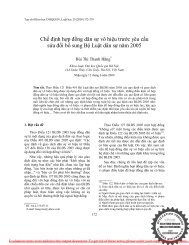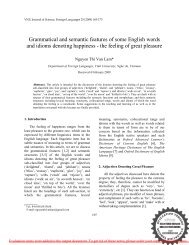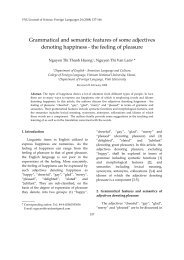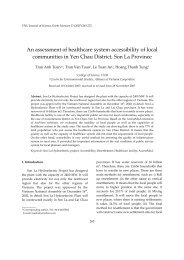Mistake or Vietnamese English - tạp chí khoa học
Mistake or Vietnamese English - tạp chí khoa học
Mistake or Vietnamese English - tạp chí khoa học
You also want an ePaper? Increase the reach of your titles
YUMPU automatically turns print PDFs into web optimized ePapers that Google loves.
44<br />
2.2. <strong>Vietnamese</strong> consonants<br />
D.T. Nu / VNU Journal of Science, F<strong>or</strong>eign Languages 25 (2009) 41-50<br />
In <strong>Vietnamese</strong>, consonants are classified<br />
into 22 initial consonants and 6 final consonants<br />
acc<strong>or</strong>ding to the positions of the consonant in a<br />
w<strong>or</strong>d (see Table 3 and Table 4). <strong>Vietnamese</strong> /s/<br />
and /z/ are alveolar fricatives, and /ʂ/ and /ʐ/<br />
are alveo-palatal fricatives. In the initial<br />
consonant system, most sounds are not much<br />
different from <strong>English</strong> sounds in terms of<br />
pronunciation. However, it is necessary to<br />
mention some differences here. First of all,<br />
unlike the <strong>English</strong> consonant system, there is no<br />
affricate in <strong>Vietnamese</strong>. The <strong>Vietnamese</strong> /ť/ is<br />
Table 3. <strong>Vietnamese</strong> initial consonants<br />
Place of articulation/Manner of Labial Alveolar Alveo-<br />
articulation<br />
palatal<br />
Stop Aspirated ť<br />
Un-aspirated voiceless t<br />
ƫ<br />
voiced b d<br />
Nasal m n<br />
Fricative<br />
Voiceless f s<br />
Voiced v z<br />
Nasal I<br />
Place of articulation/Manner of<br />
articulation<br />
Table 4. <strong>Vietnamese</strong> final consonants<br />
aspirated and sounds as if both /t/ and /h/ are<br />
involved and connected respectively but<br />
immediately, and found only in the initial<br />
position. /ć/ and /ɲ/ are typical <strong>Vietnamese</strong><br />
sounds as they are produced by the contact<br />
between the surface palate of the tongue and the<br />
hard palate (front of the palate f<strong>or</strong> /ć/ and the<br />
middle of the palate f<strong>or</strong> /ɲ/). These features of<br />
<strong>Vietnamese</strong> consonants should be taken into<br />
consideration when teaching pronunciation f<strong>or</strong><br />
<strong>Vietnamese</strong> learners of <strong>English</strong> as they may<br />
tend to affect the pronunciation of <strong>English</strong><br />
sounds.<br />
ʂ<br />
ʐ<br />
Palatal Velar Glottal<br />
ć k<br />
Labial Alveolar Velar<br />
Stop p t k<br />
Nasal m n ŋ<br />
Although there are final consonants in<br />
<strong>Vietnamese</strong>, they are never pronounced <strong>or</strong><br />
heard. That is the reason why <strong>Vietnamese</strong><br />
learners of <strong>English</strong> often omit final consonants<br />
of w<strong>or</strong>ds in <strong>English</strong>.<br />
The<strong>or</strong>etically, there are alveo-palatal in<br />
<strong>Vietnamese</strong>, but in practice, /ƫ/, /ʂ/, /ʐ/ are not<br />
ɲ<br />
ŋ<br />
ʔ<br />
x h<br />
used by people of Hanoi and in its neighbouring<br />
areas. /ƫ/, /ʂ/ are m<strong>or</strong>e often used in the central<br />
and southern regions of Vietnam. The following<br />
table (Table 5) presents the consonants of the<br />
Hanoi dialect, in which there are fricatives.<br />
ɣ








